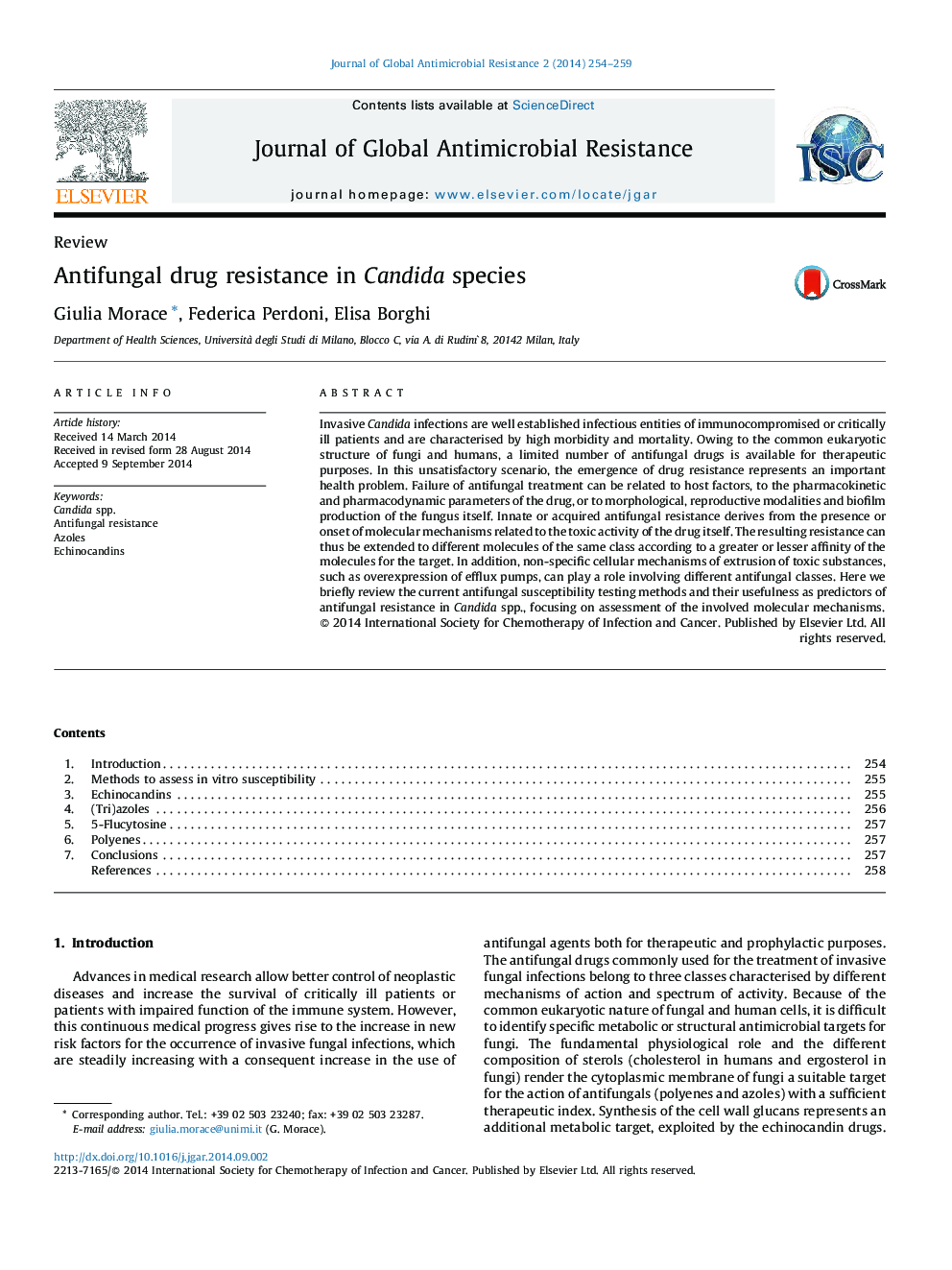| کد مقاله | کد نشریه | سال انتشار | مقاله انگلیسی | نسخه تمام متن |
|---|---|---|---|---|
| 10169936 | 1223473 | 2014 | 6 صفحه PDF | دانلود رایگان |
عنوان انگلیسی مقاله ISI
Antifungal drug resistance in Candida species
ترجمه فارسی عنوان
مقاومت به داروهای ضد قارچی در گونه های کاندیدا
دانلود مقاله + سفارش ترجمه
دانلود مقاله ISI انگلیسی
رایگان برای ایرانیان
کلمات کلیدی
ترجمه چکیده
عفونتهای کاندیدای در معرض ابتلا به عفونتهای واگیردار بیماران مبتلا به اسهال و یا بیماری های شدید هستند و به دلیل بیماری و مرگ و میر بالا هستند. با توجه به ساختار معمول یوکاریوتی قارچ ها و انسان ها، تعداد محدودی از داروهای ضد قارچی برای اهداف درمانی در دسترس است. در این سناریو ناکارآمد، ظهور مقاومت دارویی یک مشکل مهم سلامتی است. عدم درمان ضد قارچی می تواند به عوامل میزبان، به پارامترهای فارماکوکینتیک و فارماکودینامیک دارو یا به روش های مورفولوژیکی، تولید مثل و تولید بیوفیلم قارچ مربوط باشد. مقاومت در برابر قند موجود و یا در اثر آن، از وجود یا ایجاد مکانیزم های مولکولی مربوط به فعالیت سمی دارو به دست می آید. بنابراین نتیجه مقاومت به مولکول های مختلف یک کلاس می تواند بر اساس وابستگی بیشتر یا کمتر مولکول ها برای هدف گسترش یابد. علاوه بر این مکانیسم های غیر سلولی خاصی از اکستروژن مواد سمی، مانند بیش از حد بیان پمپ های خروجی، می تواند نقش متفاوتی را در کلاس های ضد قارچ ایفا کند. در اینجا ما به طور خلاصه روشهای تست حساسیت ضد قارچی کنونی و مفید بودن آنها را به عنوان پیش بینی کننده مقاومت ضد قارچی در گونه های کاندیدا بررسی می کنیم و تمرکز بر ارزیابی مکانیزم های مولکولی درگیر است.
موضوعات مرتبط
علوم زیستی و بیوفناوری
ایمنی شناسی و میکروب شناسی
میکروبیولوژی و بیوتکنولوژی کاربردی
چکیده انگلیسی
Invasive Candida infections are well established infectious entities of immunocompromised or critically ill patients and are characterised by high morbidity and mortality. Owing to the common eukaryotic structure of fungi and humans, a limited number of antifungal drugs is available for therapeutic purposes. In this unsatisfactory scenario, the emergence of drug resistance represents an important health problem. Failure of antifungal treatment can be related to host factors, to the pharmacokinetic and pharmacodynamic parameters of the drug, or to morphological, reproductive modalities and biofilm production of the fungus itself. Innate or acquired antifungal resistance derives from the presence or onset of molecular mechanisms related to the toxic activity of the drug itself. The resulting resistance can thus be extended to different molecules of the same class according to a greater or lesser affinity of the molecules for the target. In addition, non-specific cellular mechanisms of extrusion of toxic substances, such as overexpression of efflux pumps, can play a role involving different antifungal classes. Here we briefly review the current antifungal susceptibility testing methods and their usefulness as predictors of antifungal resistance in Candida spp., focusing on assessment of the involved molecular mechanisms.
ناشر
Database: Elsevier - ScienceDirect (ساینس دایرکت)
Journal: Journal of Global Antimicrobial Resistance - Volume 2, Issue 4, December 2014, Pages 254-259
Journal: Journal of Global Antimicrobial Resistance - Volume 2, Issue 4, December 2014, Pages 254-259
نویسندگان
Giulia Morace, Federica Perdoni, Elisa Borghi,
